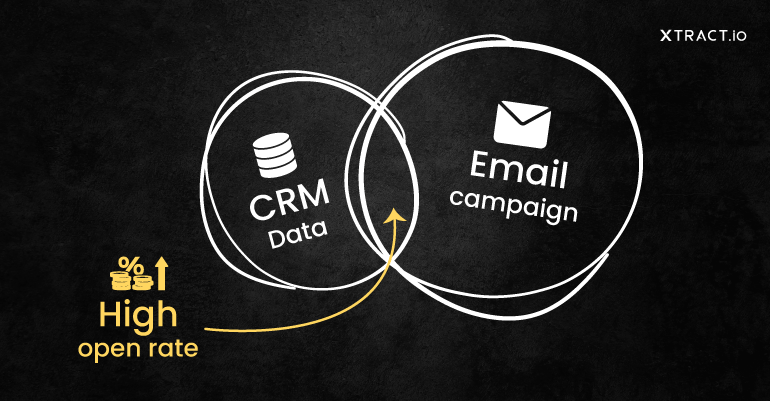As a marketer or salesperson, you’ve likely encountered discussions among colleagues about the underwhelming performance of email campaigns. However, it’s worth noting that 3.9 billion people use email daily. With such a large user base, why are our email campaign engagement rates falling short? One of the key reasons behind this predicament is the quality of our CRM data.
Most of the time, we tend to focus on our campaign’s content and subject line, often overlooking the silver lining- the quality of our customer database. People are constantly relocating, changing jobs, and organizations are merging, plaguing our CRM with outdated data. So, it is important to ensure that the data we hold in our CRM is accurate and up-to-date before sending out campaigns. Furthermore, numerous automated data refresh platforms, such as FreDa, are in the market that can swiftly update your CRM and empower you to target the right people with the most fitting message.
How does CRM data impact your email campaign?
In this 21st century, there are many ways to approach customers, such as videos, webinars, social media posts, etc. Still, an email campaign has the power to offer a personal touch while also generating revenue. So, if you’re wondering, “Does CRM data quality matters?” It does. CRM data quality and email marketing are not mutually exclusive. Obsolete CRM data can significantly affect your email campaigns and harm your brand’s reputation, while high-quality customer data can improve clicks, open rates, and email deliverability.

Here are some of the ways CRM data quality can impact your email campaign,
Inaccurate customer segmentation
Did you know that email marketing yields an ROI of 36$ for every $1 spent? It’s a powerful tool that can deliver exceptional results. However, it is not the case with every business. The ability to analyze high-quality data and segment customers efficiently distinguishes them. Customer segmentation is identifying and classifying the customer pattern based on various criteria such as work roles, product interests, revenue, job titles, etc. Leveraging such information can help you gain deeper insights about your customer and develop engaging campaigns.
Assume you want to execute an email campaign to promote your new data management tool and only want to reach marketing and sales professionals. However, only 30% of your database has job titles, and only 10% are related to the defined jobs. In this case, your email campaign cannot be a success. So, while email marketing can be a game-changer, its success hinges on the quality and accuracy of CRM data. By investing in robust CRM data refresh platforms and leveraging reliable customer segmentation techniques, businesses can unlock the true potential of email marketing and harness its remarkable ROI.
Increased bounce rate
Many of us have experienced increased bounce rates and compromised email deliverability when launching cold email campaigns to drive attention. The root cause behind this issue often lies in invalid email addresses within our database. Surprisingly, research reveals that approximately one in every three individuals changes their email address, either to evade spam or due to job transitions, rendering our customer information outdated and ineffective. The invalid email addresses will have a direct impact on the bounce rate.
However, maintaining a bounce rate above 10% can cause various issues and adversely impact your online presence. One of the main consequences is the potential blocking of your domain. When your domain gets blocked, your emails are often marked as spam and never reach your customer’s inbox. Such a high bounce rate hampers new business opportunities and becomes a challenge for nurturing your existing consumers who rely on your regular email updates. Think about it: when did you last open your spam folder? Chances are never. And that’s precisely the point. It is essential to take the time to authenticate the email list before sending out your email campaign.
Personalized email campaigns
In today’s digital world, personalized marketing is essential for firms to engage with their customers effectively. Customized emails, in particular, have developed as an effective method for connecting with individuals on a one-to-one basis. But, it is heavily reliant on the quality of the CRM data.
Analyzing behavioral, interaction, and basic data can help businesses create personalized email content. In a world of faceless emails with random content, targeting consumers with things they like or products that help solve their everyday issues can significantly increase your click rate. It begins with a simple “Hi Cathy” in the email, addressing the recipient by their full name instead of a generic and impersonal “Dear customer.” This personalized touch immediately grabs the attention. Personalization is a powerful tool that fosters a sense of connection, but achieving this is only possible when you have instant access to accurate CRM data.
Best practices to improve your email deliverability
As a salesperson or marketer, the importance of email deliverability cannot be overstated. The ultimate success of a campaign hinges on the customer opening and engaging with the email you’ve sent. However, it’s not uncommon to experience a high delivery rate with a low open rate. So, what’s the underlying issue here?

It is essential to understand that email delivery and deliverability are two separate metrics. Email delivery is when an email doesn’t bounce back. However, email deliverability goes beyond mere delivery and encompasses the number of emails reaching the customer’s inbox. High email deliverability is vital to increase open rates and ensure your message has the desired impact.
Some of the best practices to improve the deliverability ratio are:
Define the campaign’s purpose– Before you consider verifying your email list or the KPIs you need to attain, you must first determine why you are running the campaign and who your target audience are. Sending emails to only relevant customers ensures that your email marketing efforts are targeted, personalized, and more likely to produce positive outcomes.
Maintain healthy CRM data– The next step is to ensure the health of your mailing lists. In this data-driven world, where everyone generates millions of data points, periodically checking and renewing your CRM is critical. With an up-to-date CRM, you can reliably send your campaign to the appropriate person at the right time, increasing engagement and driving effective outcomes.
Tailor your email content– It is essential to tailor the purpose of your email marketing to your customer’s interests and demands. It promotes trust, fosters interaction, and establishes your brand as a trustworthy source of important information, increasing email deliverability.
Analyze email response– The next step is to analyze previous campaigns to determine what type of information resonates with your customers, when they unsubscribe, and whether clicks rise when an attachment is included. Analyzing such kind of data can help you create compelling email campaigns in the future.
Final thoughts
Take a moment to reflect and ask yourself a couple of questions. Are you sending the email campaign to the right audience? Are you confident that your CRM’s email addresses are valid and fresh? If your answer is no or uncertain, it’s time to consider incorporating an automated CRM data refresh platform like FreDa into your workflow.
FreDa empowers you to effortlessly extract the necessary information and regularly refresh your CRM without any coding experience. Connect with us for a free demo today and discover how FreDa can enable you to improve your open rates and overall campaign success.







